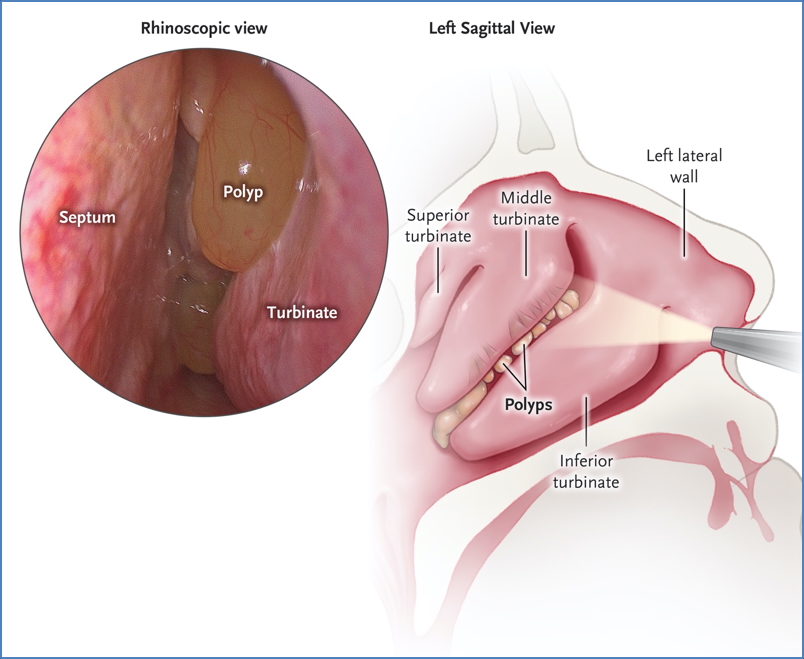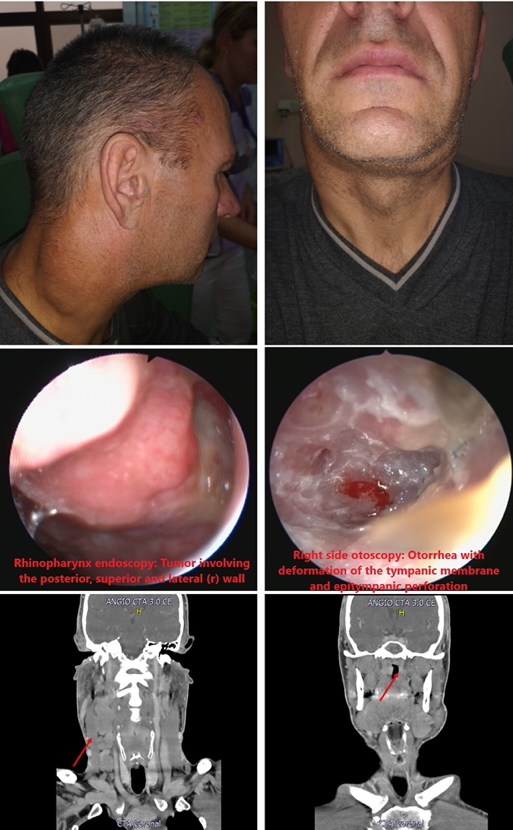Table of Contents
Overview – Nasal Tumours
Nasal tumours encompass both benign and malignant growths arising from the nasal cavity or nasopharynx. Inflammatory nasal polyps are common, non-cancerous swellings often linked to allergy or infection. In contrast, nasopharyngeal carcinoma is a malignant tumour associated with EBV and is more common in certain populations. Understanding both conditions is essential due to overlapping symptoms such as nasal obstruction and potential for serious outcomes in malignancy.
Nasal Polyps (Inflammatory)
Definition
Benign, mobile, polypoid swellings of the nasal mucosa secondary to chronic inflammation.
Aetiology
- Chronic/recurrent upper respiratory tract infections
- Allergy and hypersensitivity reactions
Pathogenesis
Chronic mucosal inflammation and oedema lead to mucosal hyperplasia and formation of polyps. These are entirely benign with no malignant potential.
Clinical Features
- Mobile, non-tender, polypoid masses within nasal cavity
- Symptoms:
- Nasal blockage
- Anosmia (loss of smell)
- Sinusitis
- Secondary infection with headache


Investigations
- Rhinoscopy
Management
- Intranasal corticosteroids (e.g. mometasone – Nasonex)
- Surgery (e.g. polypectomy) for large or symptomatic cases
Nasopharyngeal Carcinoma
Definition
A malignant neoplasm of the mucosal epithelium of the nasopharynx; the most common cancer in this region.
Aetiology
- Risk factors include:
- Epstein–Barr Virus (EBV) infection
- Genetic predisposition (e.g. Chinese or African descent)
- Male sex
Pathogenesis
Dedifferentiated carcinoma (often keratinising squamous cell carcinoma) arising from the nasopharyngeal mucosa, often with associated lymphocytic infiltrate. Tumours tend to be locally invasive and can metastasise early.
Morphology
- Dedifferentiated histology with keratinising cells
- Numerous reactive lymphocytes
- Often locally invasive
Clinical Features
- Cervical lymphadenopathy (often first presenting sign)
- Nasal obstruction or bleeding
- Trismus (jaw stiffness)
- Otitis media or hearing loss (due to Eustachian tube obstruction)
- Cranial nerve palsies
- Nasal regurgitation (from soft palate dysfunction)
- Advanced disease may include bone pain or organ dysfunction from metastasis
Investigations
- Head and neck CT or MRI
- Nasopharyngoscopy with biopsy

Management
- Excisional biopsy for diagnosis
- Radiotherapy ± chemotherapy (mainstay of treatment)
- Sentinel node resection for regional control
Summary – Nasal Tumours
This page covers both benign and malignant neoplastic conditions affecting the nasal cavity and nasopharynx. Nasal polyps are common, non-cancerous growths arising from chronic inflammation, while nasopharyngeal carcinoma is a serious malignant condition with known risk factors including EBV and genetic predisposition. For broader ENT content, visit our Head and Neck Overview page.